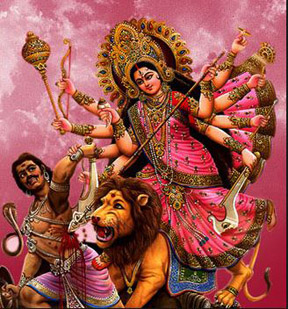 India is a ‘Land of Everlasting Festivals.’ It has several cultures that welcome the spring or the rain or the harvesting of crops, or the seeing of full moon that cause joyous celebrations splashed with colors, music, folk dances, and songs. ‘Vijayadashami’, or ‘Dasara’ or ‘Dashain’ or ‘Durgotsav’ or Tenth day of holy Navratri’, ‘or Dussehra’ is amongst the most significant Hindu festivals celebrated across India and other countries like, Nepal, Sri Lanka, and Bangladesh in September / October of every year.
India is a ‘Land of Everlasting Festivals.’ It has several cultures that welcome the spring or the rain or the harvesting of crops, or the seeing of full moon that cause joyous celebrations splashed with colors, music, folk dances, and songs. ‘Vijayadashami’, or ‘Dasara’ or ‘Dashain’ or ‘Durgotsav’ or Tenth day of holy Navratri’, ‘or Dussehra’ is amongst the most significant Hindu festivals celebrated across India and other countries like, Nepal, Sri Lanka, and Bangladesh in September / October of every year.
The name Dussehra is derived from Sanskrit word “Dasha-hara”, which literally means ‘Dasha’ – the ten-headed demon king Ravana and ‘hara’- defeat and actually referred to Lord Rama’s victory over Dashanan Ravan. This holy day also marks the victory of Goddess Durga over the demon Mahishasur.
She fought with him for 9 days and on 10th day she killed him. Therefore the name Vijayadashami is derived from the Sanskrit words “Vijaya-dashami” literally meaning the Vijay-victory on the dashami- tenth lunar day of the Hindu calendar month. Dussehra/Vijayadashami is celebrated in different ways in different part of India. This festival is relevant to many ancient Hindu epics and stories like, Ramayana, Mahishasur Vaddha by Maa Durga and the end of Agyatawas of Pandavas.
Northern India
In major northern states like, Kashmir, Uttar Pradesh, Himachal Pradesh, Haryana, Punjab, Uttarakhand and western Bihar besides the Navratri Pujan and fasts, Dussehra is celebrated more in honor of Lord Rama. During these 10 days, “Ramlila”- plays and dramas on different chapters of Ramayana are performed with full enthusiasm along with outdoor fairs and also on the 10th day the images of Ravana, his brother Kumbhakarna and son Meghanad are burnt to conclude the celebrations.
In the Kumaon region of Uttarakhand, the Dasara festival starts with unique performance of Ramlila based on the musical rendering of the katha (or story) of Lord Rama. This style of the Almora or Kumaon, Ramlila is based on the theatrical style and has been recognized by UNESCO in its 2008 report as one of the representative styles of Ramlila across India.
In the state of Himachal Pradesh, the Kullu Dussehra is a famous International Mega Dussehra festival, which allures tourists from across the globe. Kullu Dussehra is celebrated in the Dhalpur maidan of Kullu valley. It commences on the ‘Vijay Dashami’ day and continues for seven days. The history related to 17th century, when local King Jagat Singh installed an idol of Raghunath on his throne as a mark of penance.
After this practice, Lord Raghunath was declared as the ruling deity of the Valley.
This International festival of Kullu Dussehra displays traditional folk music and dance during the fair. In Manali, Hidimba, the demon is also worshipped as their kul Devi in this region because she was the wife of Bheema and the mother of Ghatodkuchh who were the powerful characters of Mahabharata and taken out in the Palaki during this festival as a deity for her good deeds.
Southern India
Vijayadashami/Dussehra is celebrated in various ways in different regions of South India. This day is observed to express gratitude to everything which brings success in life.
Celebrations include worshipping the goddess Chamundeshwari (Durga) and exhibiting colorful toys-, celebrated as Golu or Gombe Gudda in Karnataka, Kerala, Telangana, Andhra Pradesh and Tamil Nadu. The concluding and striking event in Andhra Pradesh on Vijaya Dashami is the Theppotsavam (boat festival) at Krishna – Thungabhadra Sangamam.
On Vijayadashami day, in Mysore, the goddess Chamundeshwari is worshiped and then taken out in a grand procession on a Golden Ambari (or elephant-mounted throne) across the city right from the historical Mysore Palace to the Dasara parade ground. The Mysore Palace is decorated delightfully with over 100,000 lights.
Western India
In West Bengal, Dussehra is majorly celebrated with Durga Puja which converts the whole West Bengal especially Kolkata with large magnificent beautiful pandals, minarets, domes, mountain cliffs and dazzling lighting representing the current scenario or current affairs making these 4 days of Dussehra an unforgettable event.
Eastern India
In Gujarat, Dussehra is celebrated as Navratri by majestically revering Goddess Durga is for nine days. During all of the nine nights, we can witness the traditional ‘Rasa-Garbas’, ‘Dandia ras.’ This is the longest celebration in the world.
Dasain in Nepal
Dussehra called ‘Dasain’ is the major festival of the year in Nepal. This festival is celebrated with great zeal and fervor by both, Hindu and non-Hindu Nepalis. The 10th day of Dasain is Vijayadashami; on which elders put Tika and Jamara on the forehead of younger members of the family.
Dussehra in Bangladesh
In Bangladesh, similar to Bengal, it is a five-day-long festival and celebrated in different mandaps (congregation) containing Maa Durga’s clay statues. The largest festival is celebrated at Dhakeshwari temple and Ramakrishna missionary in the country’s capital, Dhaka. On the day of Vijayadashmi (Dussehra), clay statues of the Goddess Durga are submerged in rivers.
All the devotees of Lake County are invited to participate and obtain the blessings of Maa Durga as her nine manifestations will be worshiped on each day of Navratri along with Children’s Ramaleela performance and Ravan Dahan on Vijayadashami at the Hindu Mandir of Lake County, Grayslake, IL.
Pt Anil Joshi, Grays Lake Hindu Temple






